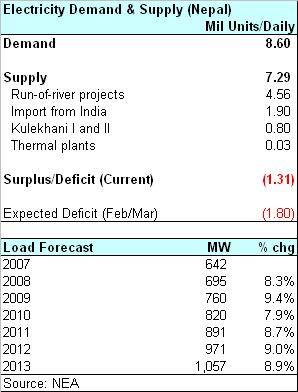BY BIKASH SANGRAULA
eKantipur.com, Jan 28
Nepalis have more to worry about than just winter power cuts. From now onwards, the country will face power cuts, either planned or unannounced, throughout the year, including during the monsoon, according to Sher Singh Bhat, chief of Systems Operations Department of Nepal Electricity Authority (NEA).
The peak load this winter is 640 megawatts (MW). Nepal's run-of-river projects, which have a total installed capacity of 458 MW, are only producing 190 MW at the moment.
Even in the coming monsoon when these projects run at full capacity, the country will face massive power deficit, as the installed capacity is just over 600 MW, including 92 MW from the two storage type Kulekhani projects and 55 MW from the country's thermal plants. Minus transmission leakage of 24 percent, the actual power availability, even in monsoon, is just around 450 MW.
"Even if all these plants run at full capacity, which is technically impossible, there will still be a power deficit in the monsoon and we will have to manage with contingency power cuts," said Bhat. "The supply situation in winter is an entirely different story."
The annual rise of power demand in the country is about 8.4 percent, according to NEA's annual report. Nepal is importing 80 MW from India. While PTC India Ltd. is willing to supply additional power to Nepal, this will not be possible until high-voltage transmission corridors are built across the Nepal-India border.
As things stand, NEA will have to enforce six hours of daily power cuts from mid-February, seven to eight hours from mid-March and six hours from mid-April, said NEA's managing director Arjun Karki. "As much as 12 hours of power cuts may be required in April 2008," he added.
Apologizing to consumers for the inconvenience caused by power cuts, Karki also requested consumers to use power judiciously.
"Shifting power consumption to times when there is power supply is not going to help. After all, there is limited power available," he said, pointing at the growing tendency among people to use as many electrical appliances as possible during hours when there is power supply.
According to Karki, electric hoarding boards that flash along the city's thoroughfares at night consume as much as 1 MW of power per hoarding board. "If situation worsens, we might have to ask them to switch off the hoarding boards or we might have to resort to disconnecting supply if that does not work," he said.
Inverters, that many people have installed in their homes and offices, are also wasting a lot of power as there is huge power loss between charging inverters and then powering the electric appliances during load-shedding hours, according to Bhat. "Solar plants are the best option, inverters the worst," Bhat said.
Nepalis will be facing crippling power cuts at least till 2009, Karki said. "We hope we will be able to build the Butwal-Anandanagar and Duhabi-Purnia high-voltage transmission corridors in two years time and thereafter import power from India to address the crisis at home to a certain extent," he said.
NEA is working to build five projects, with a total capacity of 440 MW, by 2012/13 to address power crisis at home. Among them are the 309-MW Upper Tamakoshi which NEA is trying to build with internal funds; the 61-MW Upper Trishuli for which China has offered concessional loan; the 30-MW Chameliagadh that will be built as NEA-govt joint venture; the 27-MW Raughat; and the 14-MW Kulekhani III. The only sizeable project under construction, 70-MW Middle Marsyangdi, that has hit snag after snag, will not be of much aid when it comes into operation, as the deficit will have far surpassed its generation capacity.
Karki also informed that NEA is soon signing Power Purchase Agreements with private producers for projects of 100 MW size in total. "We are also working out a plan for building projects to meet power demand after 2012/13," he added.

No comments:
Post a Comment